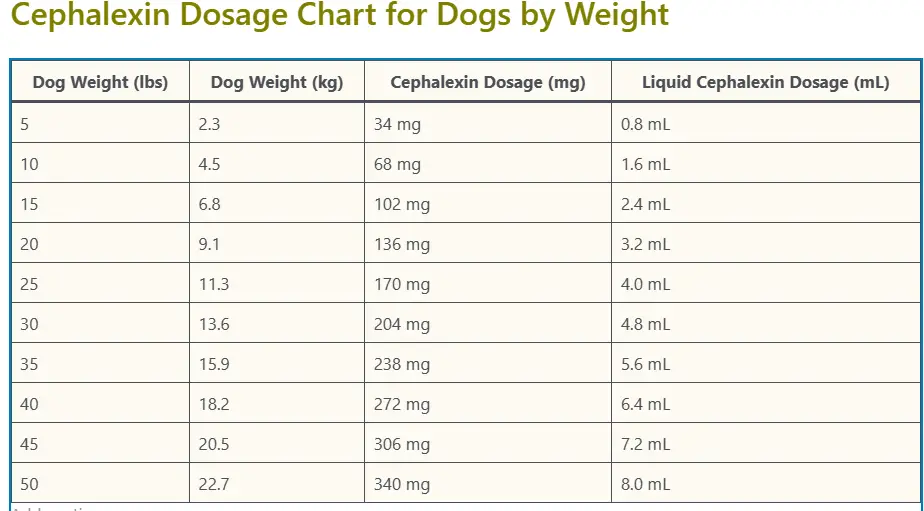As responsible pet owners, it’s crucial to understand the correct dosage of medications like cephalexin to promote the health of our canine companions. A cephalexin for dogs dosage calculator will enable you to verify whether the antibiotic amount you administer to your pet aligns with the recommended dosage.
Our Cephalexin dosage calculator for canines will inform you of the appropriate cephalexin dosage for dogs, and it will also indicate the number of tablets, or the volume of liquid required for daily therapy.
What is Cephalexin?
Cephalexin is a medication primarily used to treat bacterial infections in dogs. It belongs to the cephalosporin class of antibiotics, known for their effectiveness against various bacterial strains. It works by interfering with the formation of the bacteria’s cell walls, ultimately leading to their destruction.
How Much Cephalexin For Dogs?
The ideal dosage of cephalexin for dogs is 15mg/kg twice daily, resulting in a daily dose of 30mg/kg. This is equivalent to approximately 6.8 mg/lb twice daily, totaling 13.6 mg/lb daily. For liquid cephalexin (125 mg/5 mL), the ideal dosage for dogs is 0.6 mL/kg or approximately 0.27 mg/lb.
Disclaimer: Consulting with a veterinarian is crucial to determine the appropriate dosage for your dog. However, here’s a general guideline for cephalexin dosage based on weight:
Cephalexin Dosage Chart for Dogs by Weight
| Dog Weight (lbs) | Dog Weight (kg) | Cephalexin Dosage (mg) | Liquid Cephalexin Dosage (mL) |
|---|---|---|---|
| 5 | 2.3 | 34 mg | 0.8 mL |
| 10 | 4.5 | 68 mg | 1.6 mL |
| 15 | 6.8 | 102 mg | 2.4 mL |
| 20 | 9.1 | 136 mg | 3.2 mL |
| 25 | 11.3 | 170 mg | 4.0 mL |
| 30 | 13.6 | 204 mg | 4.8 mL |
| 35 | 15.9 | 238 mg | 5.6 mL |
| 40 | 18.2 | 272 mg | 6.4 mL |
| 45 | 20.5 | 306 mg | 7.2 mL |
| 50 | 22.7 | 340 mg | 8.0 mL |
75mg, 150mg, 250 mg, 300mg, 500mg, 600mg Cephalexin Tablets Dosage For Dogs.
| Dog Weight (lbs) | Cephalexin 75mg Tablets | Cephalexin 150mg Tablets | Cephalexin 250mg Tablets | Cephalexin 300mg Tablets | Cephalexin 500mg Tablets | Cephalexin 600mg Tablets |
|---|---|---|---|---|---|---|
| 5 | Too strong | Too strong | Too strong | Too strong | Too strong | Too strong |
| 10 | 1 | Too strong | Too strong | Too strong | Too strong | Too strong |
| 20 | 2 | 1 | Too strong | Too strong | Too strong | Too strong |
| 30 | 2 | 1 | Too strong | Too strong | Too strong | Too strong |
| 40 | 3 | 3 | 1 | Too strong | Too strong | Too strong |
| 50 | 4 | 2 | 1 | Too strong | Too strong | Too strong |
| 60 | 5 | 2 | 1 | Too strong | Too strong | Too strong |
| 70 | 6 | 3 | 2 | 1 | Too strong | Too strong |
| 80 | 7 | 4 | 2 | 2 | 1 | Too strong |
| 90 | 8 | 4 | 2 | 2 | 1 | Too strong |
| 100 | 9 | 4 | 2 | 2 | 1 | Too strong |
How Much Liquid Cephalexin For Dogs.
| Dog Weight (lbs) | Dog Weight (kg) | Liquid Cephalexin 125 mg/5 mL (0.6 mL/kg) | Liquid Cephalexin 250 mg/5 mL (0.3 mL/kg) |
|---|---|---|---|
| 5 | 2.27 | 0.54 mL | 0.27 mL |
| 10 | 4.54 | 1.08 mL | 0.54 mL |
| 15 | 6.80 | 1.62 mL | 0.81 mL |
| 20 | 9.07 | 2.16 mL | 1.08 mL |
| 25 | 11.34 | 2.70 mL | 1.35 mL |
| 30 | 13.61 | 3.24 mL | 1.62 mL |
| 35 | 15.88 | 3.78 mL | 1.89 mL |
| 40 | 18.14 | 4.32 mL | 2.16 mL |
| 45 | 20.41 | 4.86 mL | 2.43 mL |
| 50 | 22.68 | 5.40 mL | 2.70 mL |
How Does Cephalexin Work for Dogs?
Once administered, cephalexin inhibits the growth and spread of bacteria in your dog’s body. By targeting specific components within bacterial cells, it disrupts their ability to multiply, allowing the dog’s immune system to effectively combat the infection.
Related Post: Benadryl Dosage Calculator For Dogs
Benefits of Cephalexin for Canines
- Effective against a wide range of bacterial infections
- Generally well-tolerated by most dogs
- Available in various forms for easy administration
Factors Affecting Cephalexin Dosage
- Weight: Dosage often correlates with the dog’s weight, with larger dogs typically requiring higher doses.
- Severity of Infection: The extent and severity of the bacterial infection influence the prescribed dosage.
- Overall Health: Dogs with underlying health conditions may require adjustments to their cephalexin dosage.
How to Administer Cephalexin to Dogs
Cephalexin is typically available in tablet or capsule form, and it’s essential to follow your veterinarian’s instructions regarding dosage and administration.
Administer the medication with food to minimize gastrointestinal upset and ensure your dog consumes the full dose.
Monitoring and Adjusting Dosage
While cephalexin is generally safe for dogs when administered correctly, it’s essential to monitor your pet for any signs of adverse reactions or inadequate response to treatment.
Veterinary guidance is crucial when adjusting cephalexin dosage for dogs. Never alter the prescribed dosage without consulting your veterinarian, as incorrect dosing can lead to treatment failure or adverse effects.
Signs of Incorrect Dosage
- Vomiting or Diarrhea: Persistent gastrointestinal disturbances may indicate an incorrect dosage or sensitivity to the medication.
- Lethargy: Unusual tiredness or lack of energy could signal a dosage issue or underlying health concern.
- Persistent Symptoms: If your dog’s condition fails to improve or worsens despite treatment, consult your veterinarian immediately.
Cephalexin for Dogs: Potential Side Effects
While cephalexin is generally well-tolerated by most dogs, there are potential side effects to be aware of when administering this medication.
- Gastrointestinal Upset: Mild digestive disturbances such as vomiting or diarrhea may occur, particularly when the medication is administered on an empty stomach.
- Allergic Reactions: In rare cases, dogs may experience allergic reactions to cephalexin, characterized by symptoms such as itching, swelling, or difficulty breathing.
Managing Side Effects in Dogs
If your dog experiences any adverse effects while taking cephalexin, notify your veterinarian promptly. They can recommend supportive measures such as anti-nausea medication or alternative treatment options if necessary.
FAQs
What is the recommended dosage of cephalexin for dogs?
The recommended dosage of cephalexin for dogs varies based on factors such as weight, the severity of the infection, and overall health. Consult your veterinarian for personalized dosage recommendations.
How often should cephalexin be given to dogs?
Cephalexin is typically administered every 12 hours, but the frequency may vary depending on your dog’s specific condition. Follow your veterinarian’s instructions closely for optimal results.
Can cephalexin be used for puppies?
Cephalexin is generally safe for use in puppies, but dosage adjustments may be necessary. Always consult your veterinarian before administering any medication to puppies.
Are there any potential side effects of cephalexin in dogs?
Common side effects of cephalexin in dogs may include gastrointestinal upset, allergic reactions, and rare instances of liver toxicity. Monitor your dog closely for any signs of adverse effects and contact your veterinarian if necessary.
How long does it take for cephalexin to work in dogs?
The onset of action for cephalexin varies depending on the type and severity of the infection. In many cases, dogs will show improvement within a few days of starting treatment, but it’s essential to complete the full course of medication as prescribed.
Is it safe to give cephalexin to pregnant dogs?
No, cephalexin shouldn’t be given to pregnant or nursing dogs and canines who are allergic to penicillin or have kidney disease. Veterinary guidance is recommended to ensure the appropriate dosage and minimize potential risks to the mother and developing puppies.










![Can Dogs Eat Blood? 7 Side Effects [Expert Opinion]](https://petskor.com/wp-content/uploads/2022/04/Webp.net-resizeimage-12.jpg)
